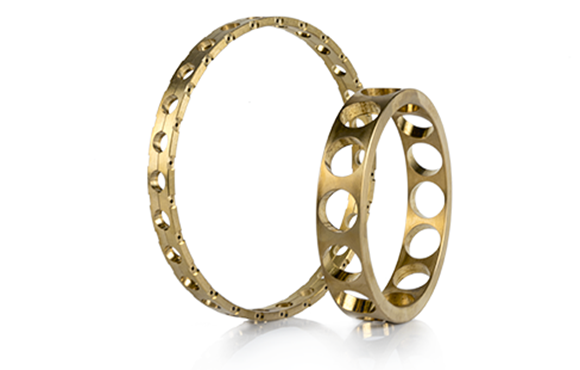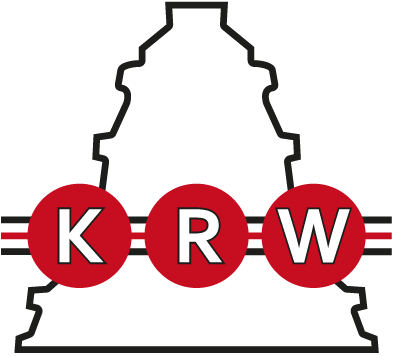
Angular Contact Ball Bearings
single row, metric
- Absorption of axial and radial forces
- Suitable for very high speeds
- Assembly by pairs

Single row angular contact ball bearings feature angular raceways of inner and outer ring and a resulting force-transferring contact angle. Due to this, an axial load always induces a radial load and the other way around, which is why angular contact ball bearings are always combined with a second bearing. Paired, they can in addition to radial forces also absorb axial and combined forces and are particularly suitable for high speeds. Single row angular contact ball bearings cannot be disassembled.
Dimensions and Tolerances
KRW supplies angular contact ball bearings with normal tolerance (PN) in accordance to DIN 620-2 (Tolerances for roller bearings) and ISO 492 (Radial bearings - Dimensional and geometrical tolerances). All other deviating or special tolerances must be specified with the order.
![[Translate to English:] Schrägkugellager - Anordnungsbeispiele Different positioning of angular contact ball bearings](/fileadmin/_processed_/f/1/csm_2_Schraegkugellager_X-O-Tandem_Anordnung_01_4b8923f828.png)
Different positioning of angular contact ball bearings in X-, O-, and tandem arrangement
Bearing Design
Angular contact ball bearings are self-latching radial bearings that cannot be disassembled. In addition to high radial forces, they can absorb single-sided axial forces as well as, in combination with a second mirror-image arranged angular contact ball bearing, two-sided axial forces. For combined bearing sets there is a distinction between O-, X- or tandem arrangement based on pressure line contact. Bearings in X-arrangement are less suitable for the absorption of moment loads while the O-arrangement is very rigid and only allows small overturning clearance. For tandem arrangements, the pressure lines of two bearings run in one direction which results in only single-sided absorption of axial forces. In the process, the axial load is absorbed by both bearings in the pair and the axial load capacity is increased.
![[Translate to English:] Aufbau eines Schrägkugellagers Structur of an angular contact ball bearings](/fileadmin/_processed_/3/8/csm_2_Schraegkugellager_Aufbau_7fda0912e2.png)
Single row angular contact ball bearing in its default design; α – contact angle
The axial load capacity of an angular contact ball bearing is increased with a larger contact angle. Angular contact ball bearings of the series 72B, 73B and 74B are by default supplied with a contact angle of 40°, the series 708, 709, 718, 719 and 70 (without suffix B) with 30°.
Bearing Clearance and Preload
Angular contact ball bearings are divided into clearance classes and preload classes. These are not standardised. KRW bearing clearance classes and preload classes are defined by suffixes.

Cage
By default, angular contact ball bearings by KRW are equipped with a roller riding solid brass window-type cage (suffix: MP). Other cage designs are available on request or chosen for specific applications and labelled accordingly on the bearing.
Special Suffixes
| B | Modified internal design, contact angle 40° |
| D | Modified internal design, contact angle 20° |
| E | Modified internal design, contact angle 25° |
Compensation of Angular Misalignments
Single row angular contact ball bearings are of limited suitability for compensation of misalignments. The admissible misalignment between inner and outer ring depends on the bearing size, the internal bearing design, the clearance fit, and the acting of forces and moments. Misalignments cause harmful ball movement and produce additional stresses in the bearing which reduce its operating life.
Speed
KRW distinguishes between kinematic limiting speed nG and thermal reference speed nth. The kinematic limiting speed is a practical mechanical limit value and is based on the mechanical fatigue strength of the rolling bearing as a function of its installation situation and lubrication. The limit speed must not be exceeded even under optimum operating conditions without prior consultation with KRW.
The thermal reference speed represents the equilibrium between the heat generated in the bearing by friction and the heat flow dissipated. It is standardised in DIN ISO 15312 (Rolling bearings - Thermal reference speed).
Admissible Operating Temperatures
The admissible operating temperature of a bearing is limited by cage material, dimensional stability of the bearing components (ball race and rolling elements), as well as lubrication. By default, KRW bearings are stabilised up to 200°C (S1). KRW provides roller bearings for higher operating temperatures on request.
Dimensioning
For dynamically loaded bearings
The service life formula according to ISO 281 L10 = (C/P)p for dynamically loaded bearings requires an equivalent load (P) from constant direction and size. To calculate P, calculation factors and the ratio of axial and radial load are required. This is shown in the following equations.
Equivalent Dynamic Bearing Load P
a) Single bearings and tandem arrangement
The equivalent bearing load P for dynamically loaded single bearings or bearings in tandem arrangement depends on the ratio Fa/Fr (axial force / radial force). The equivalent dynamic bearing load can then be determined using the following formula:

| P | equivalent dynamic load | [kN] |
| Fr | dynamic radial force | [kN] |
| Fa | dynamic axial force | [kN] |
| e | calculation factor, see chart | [-] |
| X | calculation factor, see chart | [-] |
| Y | calculation factor, see chart | [-] |
| Series | e | X | Y |
| 708, 709, 718, 719 | 0,80 | 0,39 | 0,76 |
| 72B, 73B, 74B | 1,14 | 0,35 | 0,57 |
b) O- and X-arrangement
The equivalent bearing load P for dynamically loaded bearings in O- or X-arrangement depends on the ratio Fa/Fr (axial force / radial force). The equivalent dynamic bearing load can then be determined using the following formula:

| P | equivalent dynamic load | [kN] |
| Fr | dynamic radial force | [kN] |
| Fa | dynamic axial force | [kN] |
| X | calculation factor, see chart | [-] |
| Y | calculation factor, see chart | [-] |
| Series | Fa / Fr | X | Y |
| 708, 709, 718, 719 | ≤ 0,80 | 1 | 0,78 |
| > 0,80 | 0,63 | 1,24 | |
| 72B, 73B, 74B | ≤ 1,14 | 1 | 0,55 |
| > 1,14 | 0,57 | 0,93 |
Resulting axial force for O- and X-arranged roller bearings
Due to the angular raceways, when a radial force occurs, angular contact ball bearings generate an axial reactive force which is relevant to the bearing dimensioning. When a shaft is supported by two identical or differently sized angular contact ball bearings, the radial load of one bearing produces an axial load for the other bearing. This internal resulting force must be considered when determining the total axial load. The value of the total axial load on a single bearing is determined with the following formulas:
| case | load ratio | outer force | resulting axial force Fa | |
| bearing A | bearing B | |||
| 1 | FrA / YA ≤ FrB / YB | Ka ≥ 0 | Fa = Ka + 0,5 ∙ FrB / YB | Fa is not considered in the calculation |
| 2 | FrA / YA > FrB / YB | Ka > 0,5 · ( FrA / Ya - FrB / YB ) | Fa = Ka + 0,5 ∙ FrB / YB | Fa is not considered in the calculation |
| 3 | FrA / YA > FrB / YB | Ka ≤ 0,5 ∙ ( FrA /YA - FrB /YB ) | Fa is not considered in the calculation | Fa = 0,5 ∙ FrA / YA - Ka |
To the formulas applies that the bearings being affected by the outer axial force Ka are marked with A and the counter bearings with B. All bearings are backlash-free and considered without preload.
| FrA | radial force in bearing A | [kN] |
| FrB | radial force in bearing B | [kN] |
| YA | calculation factor for bearing A (see chart X- and O-arrangement) | [-] |
| YB | calculation factor for bearing B (see chart X- and O-arrangement) | [-] |
| Ka | outer axial force | [kN] |
| Fa | resulting axial force | [kN] |

c) Reduction of dynamic load rating in a bearing set
For identical angular contact ball bearings assembled directly side by side in X-, O-, or tandem arrangement, the load rating of the bearing set must be reduced. For the dynamic load rating, the following correlation applies:

| Cr | dynamic load rating of the bearing set | [kN] |
| Cr, single bearing | dynamic load rating of the single bearing | [kN] |
| i | number of identical bearings in bearing set | [-] |
For statically loaded bearings
Dynamic dimensioning loses its validity for bearings rotating at very low speeds (n x dm ≤ 4000 mm/min). The static load safety factor S0 is calculated as follows:

| S0 | static load safety factor | [-] |
| C0 | basic static load rating (from bearing chart) | [kN] |
| P0 | equivalent static bearing load | [kN] |
| n | bearing speed | [min-1] |
| dm | mean bearing diameter [dm = (D+d)/2] | [mm] |
Static load capacity
a) single bearings or tandem arrangement
For statically loaded single row or tandem arranged angular contact ball bearings, the following correlations apply:

| F0r | max. radial static force | [kN] |
| F0a | max. axial static force | [kN] |
| Series | X | Y |
| 708, 709, 718, 719 | 0,5 | 0,33 |
| 72B, 73B, 74B | 0,5 | 0,26 |
b) X- und O-arrangement
For statically loaded angular contact ball bearings in X- or O-arrangement, the following correlations apply:

| F0r | max. radial static force | [kN] |
| F0a | max. axial static force | [kN] |
| Series | X | Y |
| 708, 709, 718, 719 | 1 | 0,66 |
| 72B, 73B, 74B | 1 | 0,52 |
c) Reduction of static load rating in a bearing set
For identical angular contact ball bearings assembled directly side by side in X-, O-, or tandem arrangement, the load rating of the bearing set must be calculated. For the static load rating, the following correlation applies:

| C0 | static load rating of the bearing set | [kN] |
| C0, single bearing | static load rating of the single bearing | [kN] |
| i | number of identical bearings in bearing set | [-] |
Minimum Radial Load
A minimum load is required for the reliable operation of a rolling bearing. If the minimum load is not reached, slippage may occur. The minimum radial load for angular contact ball bearings is roughly assumed to be 1% of the static load rating C0 of the bearing. If the value falls below this value, consult KRW Application Engineering.



